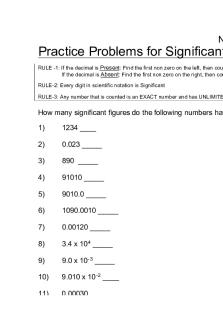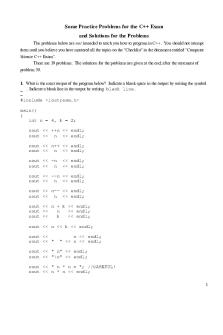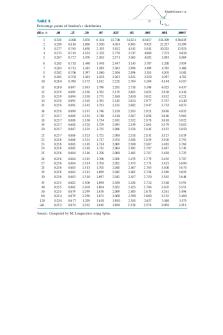Practice Problems for Final PDF

| Title | Practice Problems for Final |
|---|---|
| Author | Yuntong Deng |
| Course | Intro to Process Analytics |
| Institution | University of Notre Dame |
| Pages | 10 |
| File Size | 93.2 KB |
| File Type | |
| Total Downloads | 71 |
| Total Views | 161 |
Summary
Dr. Yilmaz...
Description
ITAO 30800 – Introduction to Process Analytics Practice Problems for Final This document is intended only for practice and review to prepare for the midterm. It is not reflective of the length, exact questions or importance of certain topics on the midterm. It should only be considered as a complement to your slides, notes, readings, exercises and problems.
1. Sarah’s Silk Screening sells souvenir shirts. Sarah is trying to decide how many to produce for an upcoming event, which will be only held once at the Business school. The University will allow her to sell the shirts only on one day, the day of the event. Sarah will sell the T-shirts for $20 each. When the event day is over, she will be allowed to sell the remaining stock to the Bookstore for $4 each. It costs Sarah $8 to make the specialty shirt. She estimates mean demand (following a Normal distribution) to be 545, with a standard deviation is 115. How many shirts should she make?
2. You have decided to open a mail-order shoe business once you graduate from Notre Dame. One of the problems you face is that you have to print the catalog and order all your items before the selling season, and there is no opportunity to re-order or change the catalog once the selling season begins. You can purchase shoes for $12 per unit from your supplier and sell them for $20 per unit. If you are left with any shoes at the end of the season, you can sell them through a discount outlet for $10 per unit. You estimate that total demand during the season will be normally distributed with mean 1000 and standard deviation 100. a. What is the critical fractile? b. How many shoes should you order? c. How would the order size change if the selling price during the season increases?
3. The local supermarket buys lettuce every day to ensure really fresh produce. Each morning any lettuce that is left from the previous day is sold to dealer that resells it to farmers who use it to feed their animals. This week the supermarket can buy lettuce for $4 a box. The lettuce is sold for $10 a box and the dealer that sells old lettuce is willing to pay $1.5 per box. Past history says that tomorrow’s demand for lettuce averages 250 boxes with a standard deviation of 34 boxes. How many boxes of lettuce should the supermarket purchase tomorrow?
4. If we reduce the setup (ordering) costs, order quantity (EOQ) should increase. True or False?
5. Safety stock can be defined as the amount of inventory carried in addition to the expected demand. True or False?
6. Safety stock can be computed when using the economic order quantity inventory model by multiplying a "z" value representing the number of standard deviations to achieve a service level or probability by the standard deviation of daily demand. True or False?
7. The Great Southern Automotive Co. buys steering wheels from a supplier. One particular steering wheel has a known and constant demand rate of 2,000 units per year. The fixed cost of ordering is $100 and the inventory holding cost is $2 per unit per year. It takes 2 weeks for an order to arrive. Compute a. The optimal order quantity b. The reorder point c. The average inventory level d. The time between successive orders e. The total annual ordering and inventory holding cost f.
If demand was variable with a standard deviation of 4 units per week, and the firm aims for 98% customer satisfaction, what would the reorder point be?
8. Assuming no safety stock, what is the re-order point given an average daily demand of 50 units, a lead time of 10 days and 625 units on hand?
9. Assuming no safety stock, what is the re-order point given an average daily demand of 78 units and a lead time of 3 days?
10.If annual demand is 12,000 units, the ordering cost is $6 per order and the holding cost is $2.50 per unit per year, what is the optimal order quantity using the economic order quantity model?
11.If annual demand is 50,000 units, the ordering cost is $25 per order and the holding cost is $5 per unit per year, what is the optimal order quantity using the economic order quantity model?
12.Using the economic order quantity model, what is the total ordering cost of inventory given an annual demand of 36,000 units, a cost per order of $80 and a holding cost per unit per year of $4?
13.If it takes a supplier 25 days to deliver an order once it has been placed and the standard deviation of daily demand is 20, what is the standard deviation of demand during lead time?
14.If it takes a supplier four days to deliver an order once it has been placed and the standard deviation of daily demand is 10, what is the standard deviation of demand during lead time?
15.A company wants to determine its reorder point (ROP). Demand is variable and they want to build a safety stock into ROP. If the average daily demand is 12, the lead time is 5 days, the desired "z" value is 1.96 and the standard deviation of demand during lead time is 3, what is the desired value of ROP?
16.A company wants to determine its reorder point (ROP). Demand is variable and they want to build a safety stock into ROP. The company wants to have a service level of 95 percent. If average daily demand is 8, lead time is 3 days and the standard deviation of demand during lead time is 2, what is the desired value of ROP?
17.Ray’s Satellite Emporium wishes to determine the best order size for its bestselling satellite dish. Ray has estimated the annual demand for this model at 1000 units. His cost to carry one unit is $100 per year per unit, and he has estimated that each order costs $25 to place. Using the EOQ model, how many should Ray order each time?
18.Each year the firm on a random basis uses about 2000 of item X which costs $25 each. Storage costs, which include insurance and cost of capital amount to $5 per unit per year. Every time an order is placed, it costs $10. a. What should the order size be? b. What is the annual cost of ordering item X? c. What is the annual cost of storing item X?
19.The annual demand for a product is 15,600 units. The weekly demand is 300 units with a standard deviation of 90 units. The cost to place an order is $31.20 and the time from ordering to receipt is 4 weeks. The annual inventory carrying cost is $0.1 per unit. Find the reorder point necessary to provide a 98 percent service level. Suppose the manager has been asked to reduce the safety stock of this item by 50 percent. If she does so, what will the new service level be?
20.Powered by Koffee (PBK) is a new campus coffee store. PBK uses 50 bags of whole bean coffee every month, and you may assume that demand is perfectly steady throughout the year. PBK has signed a year-long contract to purchase its coffee from a local supplier, Phish Roasters, for a price of $25 per bag and an $85 fixed cost for every delivery independent of the order size. The holding cost due to storage is $3 per bag per month. PBK managers figure their cost of capital is approximately 2 percent per month. a. What is the optimal order size, in bags? b. Given your answer in (a), how many times a year does PBK place orders? c. How many months of supply of coffee does PBK have on average? d. On average, how many dollars per month does PBK spend to hold coffee (including cost of capital)?
21.Maxine's Mobile Home Co. experiences a yearly demand of 520 units for mobile homes; Maxine incurs a cost of $1000 every time she places a new order with the factory. She estimates her inventory holding costs at $1,200 per unit per year. Compute a. The optimal EOQ b. The number of orders per year c. The length of the order cycle d. Maxine waits 2 weeks to receive an order. What would the reorder point be if the weekly standard deviation in demand were 2 and Maxine wanted to achieve a 95% service level?
22.Webster Chemical Company produces mastics and caulking for the construction industry. The product is blended in large mixers and then pumped into tubes and capped. Webster is concerned whether the filling process for tubes of caulking is in statistical control. The process should be centered on 8 ounces per tube. Several samples of eight tubes are taken and each tube is weighed in ounces. Observations Samp le 1 2 3 4 5 6
1
2
3
4
5
6
7
8
7.98 8.23 7.89 8.24 7.87 8.13
8.34 8.12 7.77 8.18 8.13 8.14
8.02 7.98 7.91 7.83 7.92 8.11
7.94 8.41 8.04 8.05 7.99 8.13
8.44 8.31 8 7.9 8.1 8.14
7.68 8.18 7.89 8.16 7.81 8.12
7.81 7.99 7.93 7.97 8.14 8.13
8.11 8.06 8.09 8.07 7.88 8.14
a. Complete the table. b. Is the process variability in statistical control?
Mea n
Ran ge
8.16
0.43 0.32
8.05 7.98 8.13
c. Quality team mentioned that the scale used for Sample 6 had an issue. Drop Sample 6 from your analysis and share your conclusion on the process variability and process average.
23.A Coke Zero can has design specifications of 12 ±0.4 ounces. Coca-Cola Bottling Plant in Bloomington produces cans with an average of 11.9 and a standard deviation of 0.08 ounces. Is this process capable at 3σ, 4σ, 5σ, 6σ?
24.A control chart typically does NOT show which of the following values? a) Lower control limit b) Upper control limit c) Nominal value d) Target control limit
25.TQM stresses three principles for achieving high levels of process performance and quality. Which of the following is one of them? a. Continuous employee improvement b. Life-long employment c. Management leadership d. Customer satisfaction 26. At Isogen Pharmaceuticals, the filling process for its asthma inhaler is set to dispense 140 milliliters(ml) of steroid solution per container. The average range
for a sample of 6 containers is 4 ml. Establish control limits for sample means and ranges for the filling process....
Similar Free PDFs

Practice Problems for Final
- 10 Pages

Final Exam Practice Problems
- 5 Pages

Practice problems for Sig Figs
- 2 Pages

Practice problems for test 1
- 4 Pages

Practice Problems for Midterm 1
- 83 Pages

Practice-final - Practice final
- 7 Pages
Popular Institutions
- Tinajero National High School - Annex
- Politeknik Caltex Riau
- Yokohama City University
- SGT University
- University of Al-Qadisiyah
- Divine Word College of Vigan
- Techniek College Rotterdam
- Universidade de Santiago
- Universiti Teknologi MARA Cawangan Johor Kampus Pasir Gudang
- Poltekkes Kemenkes Yogyakarta
- Baguio City National High School
- Colegio san marcos
- preparatoria uno
- Centro de Bachillerato Tecnológico Industrial y de Servicios No. 107
- Dalian Maritime University
- Quang Trung Secondary School
- Colegio Tecnológico en Informática
- Corporación Regional de Educación Superior
- Grupo CEDVA
- Dar Al Uloom University
- Centro de Estudios Preuniversitarios de la Universidad Nacional de Ingeniería
- 上智大学
- Aakash International School, Nuna Majara
- San Felipe Neri Catholic School
- Kang Chiao International School - New Taipei City
- Misamis Occidental National High School
- Institución Educativa Escuela Normal Juan Ladrilleros
- Kolehiyo ng Pantukan
- Batanes State College
- Instituto Continental
- Sekolah Menengah Kejuruan Kesehatan Kaltara (Tarakan)
- Colegio de La Inmaculada Concepcion - Cebu









